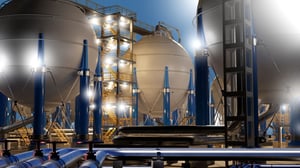
Capabilities




Overview
Build compressible flow systems with drag-and-drop sketching, visual feedback, and clear input-to-result validation in a graphical interface.
Simulate high-speed acoustic transients—including choked flow conditions—and complex events like turbine trips, blowdowns, and ruptures with precision.
Analyze multiple design cases and complex event logic (e.g., valve actions, compressor changes) in one file for comparative and operational simulations.
Visualize and graph results, export unbalanced forces for use in pipe stress tools, and send data to Excel or reporting templates for analysis.
Modeling features
Compressors
- Centrifugal compressor support: Define behavior using performance curves detailing pressure or head versus flow.
- Fixed-flow positive displacement model: Represents positive displacement compressors with a constant flow output, allowing the system to determine necessary pressure rise.
- Detailed reciprocating compressor modeling: Capture physical behavior by specifying bore, stroke, clearance, rod dimensions, cylinder arrangement (single, inline, opposed, vee), crankshaft geometry, and valve timing.
- Support for single and double acting designs: Accurately model configurations that compress gas via one or both sides of the piston, including accounting for rod volume.
- Multi-cylinder configurations: Handle up to six cylinders per compressor junction, with automatic crank angle offsets and crankshaft phase shift for inline, opposed, or vee arrangements.
- Holistic transient behavior: Model suction and discharge dynamics together—pressure, flow, and energy interact naturally within the system rather than being imposed.
- Thermodynamics-based transient simulation: Reciprocating compressors drive transient response directly from their geometry and gas thermodynamics, without preset periodic flow assumptions.
- Optional frequency analysis integration: Leverage the PFA (Pulsation Frequency Analysis) module to use reciprocating compressors as pulsation sources and predict resonance effects.

Pipes
- Graphical drag-and-drop layout: Build pipe networks visually using an intuitive interface that shows inputs and results directly on the layout.
- Automated pipe sectioning: Divides pipes into segments based on acoustic velocities from steady-state calculations to optimize transient analysis accuracy.
- Standard library materials: Select from built-in pipe materials with predefined sizes and schedules, or define custom pipe geometry and accounts for scaling and roughness.
- Friction control flexibility: Choose from absolute or relative roughness, hydraulically smooth, or explicitly enter a custom friction factor for each pipe segment.
- Thermal modeling options: Apply various heat transfer modes, such as adiabatic, convective, heat flux, or heat tracing, including accounting for fluid and wall temperature changes.
- Heat capacity and tank integration: Include transient wall capacitance effects or finite tank interactions to capture dynamic thermal behaviors in piping systems.
- Flow-division modeling at junctions: Apply accurate loss correlations through tees and branches to reflect realistic pressure drop dynamics in complex networks.
- Visual feedback and validation: View pipe properties, flow behavior, and analysis output right within the schematic to catch modeling errors early and improve iteration speed.

Valves
- Valves as defined junctions: Model control or flow-restricting components at specific pipe junctions to accurately represent localized pressure losses.
- Cv/Kv and xT-based loss modeling: Define valve losses using industry-standard Cv (or Kv) values with automatic conversion and handling of both subsonic and choked (sonic) flow conditions.
- Equal percentage characteristic option: Choose valve lift profiles that increase flow rate proportionally to the previous opening, following equal percentage behavior.
- Control valves with active feedback: Specify flow-control or pressure-control behavior, where valves adjust to maintain setpoints and dynamically switch to passive loss behavior if limits are exceeded.
- Transient behavior control: Assign time-based or event-triggered valve position changes using transient data tables—ideal for simulating closures, openings, or dynamic setpoint changes.
- Check valve dynamics: Model directional flow control with user-defined closing velocity and reopen pressure differential; valve may close passively if reverse flow occurs.
- Relief valve setpoint modeling: Implement relief valves that open instantly when upstream stagnation pressure reaches a defined threshold and remain open for the simulation duration.
- Special conditions handling: Override valve states (e.g., forced open or closed) for specific scenarios or testing, and flag repeated transient data with presets to control its activation.

Flow properties
- Compressible one-dimensional flow: Solves full mass, momentum, and energy balance in each pipe segment using a modified Newton–Raphson solver paired with the Method of Characteristics for transients.
- Real-gas behavior: Accounts for non-ideal gas characteristics using a compressibility factor derived from supported property libraries, ensuring accurate thermodynamic modeling.
- Automatic pipe sectioning: Divides pipes into segments based on steady-state acoustic velocities to ensure transient fidelity without manual segmentation.
- Sonic choking detection: Recognizes and models choking when local velocities reach Mach 1, including during transients, switching to appropriate CdA-based loss modeling.
- Diverse fluid property libraries: Includes built-in standard fluid datasets plus NIST REFPROP and optional Chempak databases—enabling fluid mixtures, various equations of state, and tailored accuracy.
- Energy-conserving junction modeling: Treats all junctions except heat exchangers and compressors as isenthalpic, maintaining constant stagnation enthalpy across connections.
- Assigned flow and pressure boundaries: Supports specifying fixed flow rates or pressures at junctions—including irrecoverable losses or time-based profiles—for boundary control.
- Mixtures support: Enables definition and simulation of non-reacting multi-component gas mixtures for more complex system scenarios.

Import/Export capabilities
- Cross-product model transfer: Open models from Arrow directly in xStream.
- Import from PCF, CAESAR II, GIS, EPANET: Use a wizard to bring in piping layouts from Piping Component Files (.pcf), CAESAR II neutral files, GIS shapefiles, or EPANET files, with controls for merging, filtering, and previewing content.
- Export to EPANET: Convert xStream models back into EPANET format for compatibility with open-source hydraulic modeling workflows.
- Excel-based model control: Use the Excel Import feature to update model parameters across pipes and junctions via a structured spreadsheet—ideal for batch edits or scenario setup.
- Automated Excel exports: Configure the Excel Export Manager to send output data directly into specific spreadsheet cells or worksheets during batch runs.
- Merge external models: Integrate external model files into the current workspace using the merge tool—helpful for combining system sections or collaborative modeling.
- Force file export for stress analysis: Export unbalanced pipe forces into formats compatible with downstream tools like CAESAR II, ROHR2, AutoPIPE, or TRIFLEX for stress modeling.
- Batch scenario export: Run multiple scenarios in sequence and export output results in one pass using batch automation, streamlining multi-case analysis.

Scenario Manager
The Scenario Manager capabilities are one of the most valuable and time-saving features for system design and comparison:
- Design Iteration Tracking – Safely explore “what-if” conditions, pump failures, or demand changes without losing your base model.
- Hierarchy-Based Scenario Tree – Organize scenarios in a structured tree with inheritance to avoid repetitive data entry and maintain consistency.
- Easy Switching Between Scenarios – Instantly toggle between scenarios for side-by-side analysis, design evaluation, and troubleshooting.
- Multi-Case Modeling in One File – Store unlimited design alternatives, operating conditions, or failure scenarios within a single project.
- Input Inheritance – Share common data across scenarios (e.g., geometry, fluids) while varying only selected inputs—greatly reducing maintenance.
- Scenario Comparison Tool – Highlight differences in input data and output results across multiple cases for clear, data-driven decisions.
- Scenario Export & Reuse – Export individual scenarios or branches for reuse in other models or for team collaboration.
- Batch Run Capability – Run multiple scenarios automatically and review results efficiently, saving time during optimization studies.

Reporting features
Output
- Customizable output control: Select which parameters, units, and the display order appear in the Output window to suit your reporting needs.
- Context-aware right-click actions: Right-click on cells or headers in the Output table to change units, sort data, copy values, export to Excel, or locate the associated object in the model.
- Transient max/min summaries: View the maximum and minimum values of transient data, along with timing and location, in either detailed or summary formats.
- Output formatting options: Configure printable reports via a Print Content window, adjusting content and style (font, layout) before exporting to PDF or print.
- Quick parameter access: Highlight cells, rows, or columns to see calculations like max, min, sum, mean in the selection tab, enabling rapid insight into output data.
- Consistent scenario outputs: Save solver results to output files (.out), with distinct files per scenario for traceability and repeatable report generation.
- Initial guess update tool: Instantly transfer steady-state results as the starting condition for subsequent runs, speeding up convergence during iterative modeling.
- Adjustable display zones: Resize and collapse General, Pipe, and Junction sections in the Output window for cleaner layout and focused data viewing.

Visual results
- Layer-based visualization: Use workspace layers, such as stacked transparencies, to control visibility of inputs, outputs, annotations, and model graphics directly in the workspace.
- Color map integration: Apply customizable color maps as independent layers to visually indicate conditions like pressure gradients or reverse flow without altering core schematic elements.
- Animated transient views: Display dynamic flow and pressure changes through animation layers to watch how waves propagate in real time across the system.
- Preset management: Save and recall layer visibility settings and color/animation behavior as presets; optionally link them to specific scenarios for automatic switching.
- Interactive style control: Adjust appearance (colors, line thickness, labels) per layer, with real-time updates visible on the workspace.
- Selective visibility for clarity: Hide or show only the information you want, such as inputs, outputs, or annotations, through layer toggling to focus your analysis.
- Composed views from multiple layers: Stack standard and advanced layers (e.g., all objects, color maps, labels) to build layered visual contexts for complex systems.
- Streamlined compared to old reports: Layers replace the older Visual Reports, offering more flexibility. No need to leave the workspace to adjust what you’re seeing.

Graph results
- Multiple graph types – Create transient plots for pipe/junction data, profile views along flow paths, force vs. time charts, and frequency response graphs for pulsation analysis.
- Multi-scenario comparison – Overlay results from different scenarios in one graph to easily compare performance across design variations.
- Flexible formatting – Adjust axis styles, labels, colors; stack multiple series; or use dual Y-axes for clearer visualization.
- Graph management – Save, organize, and regenerate graphs easily using folders and templates for consistent reuse across projects.
- Annotations & data tools – Add notes, crosshairs, or annotations; display XY data; zoom into ranges with a range finder for detailed analysis.
- Export options – Copy graphs as images, export X-Y data, save in common formats like PNG or PDF, or even record animated graphs as video files.
- Animation of profile data – Animate results over time using profile graphs to observe how pressure and flow waves propagate through the system.
- Workspace graph embedding – Place graph annotations directly onto the schematic, keeping visual context and enabling side-by-side comparisons between graph and model areas.

Supported codes & standards
ASME
- ASME Steam Tables (IAPWS-IF97): Contains a built-in library based on the established ASME 1997 steam property formulation, aiding accurate modeling of steam thermodynamics.
- Gas Relief System Piping Standards: Supports industry-recognized ASME (as well as API and ISO) guidelines for safe design and analysis of gas relief piping systems.
- Applied Standards Tracking: Highlights which ASME-related standards were used for specific calculations (e.g., for valve loss models) in the Output Window, improving traceability and documentation.

Hydraulic Institute Standards
- ANSI/ISA-75.01.01-2012 Valve Flow Definitions: Uses this standard for Cv and Xt calculations in compressible flow, ensuring consistency with widely accepted valve sizing and characterization methods.
- ANSI/API 526 Relief Valve Reference: Applies standard dimensions and characteristics for flanged steel pressure-relief valves to support accurate relief system modeling.
- Hydraulic Institute Guidelines: Aligns with industry-recommended practices for pump and system design through Datacor’s active participation in Hydraulic Institute standards development.

API Standards
- API 526 (Flanged Steel Pressure Relief Valves): Supports modeling and sizing of relief valves in accordance with the dimensional and performance specifications outlined in this standard.
- API Guidelines for Gas Relief Systems: Incorporates recognized API practices for evaluating relief system capacity, piping configuration, and safe discharge conditions.

International Standards
- DIN and JIS Pipe Standards: Includes pipe material and dimension libraries from German (DIN) and Japanese (JIS) standards to support global project specifications.
- ISO Standards for Gas Relief Systems: Aligns with ISO guidelines for the design and analysis of gas relief and venting systems alongside ASME and API practices.
- International Fluid Property Databases: Supports integration with NIST REFPROP and optional Chempak libraries, enabling accurate thermophysical properties for a wide range of international applications.

Other Standards
- ASTM Material Standards: Provides pipe and material properties consistent with ASTM specifications for strength, roughness, and temperature limits.
- AWWA Pipe Standards: Includes data for waterworks piping systems following AWWA guidelines, where applicable to steam or gas service.
- MSS-SP Valve Standards: Supports valve dimension and pressure class definitions from the Manufacturers Standardization Society.

Add-on Modules
Software extension tools that can help you quickly and efficiently complete projects. Modules can work individually or together.
Helps identify pipe acoustical frequencies to avoid resonance from excitation, especially in systems with positive displacement pumps and reciprocating compressors. Used with either Impulse or xStream.
The Chempak add-on utility provides a thermophysical database of almost 700 liquids and 600 gases with mixing capability.
Discuss your pipe flow modeling software goals with a simulation expert.
“To solve [my task] I needed specialized software which can estimate all necessary flows and pressures in every branch of the system."